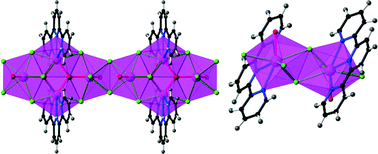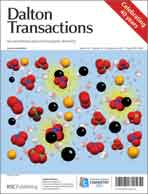The solvothermal reactions (at 180 °C for 48 h) of a mixture of lanthanide chlorides (Nd, Eu) with the tridendate heterocyclic nitrogen ligand, 2,2′:6′,2′′-terpyridine (terpy), in ethanol medium give rise to the formation of crystalline mixed chloro-hydroxo-aquo complex Ln2Cl5(OH)(H2O)(terpy). Its crystal structure consists of the connection of eight- and nine-fold coordinated lanthanide centers linked to each other viaμ2,3-chloro and μ3-hydroxo species to form a tetranuclear unit, which are then further connected through chloro edges to generate infinite ribbons. Only one lanthanide cation in every two is chelated by terpy. Similar molar composition of the starting reactants led to the crystallization at room temperature of a second type of complex LnCl3(H2O)(terpy) (Ln = Nd, Eu). It is built up from the molecular assembly of dinuclear species containing two eight-fold coordinated lanthanide centers chelated by terpy and linked through a μ2-Cl edge. Luminescence spectra have been collected for the europium-based compound and indicates a strong red signal with the expected bands from the F–D transitions. The magnetic properties of the four compounds were investigated. Their behaviors correspond to that of the rare-earth ions present in the structure. The magnetic susceptibility of the neodymium-based compounds agrees with that of the Nd(III) ion with an 4I9/2 ground state split by crystal field. Concerning the Eu(III) derivatives, the term 7F is split by spin–orbit coupling, the first excited states being thermally populated. Accordingly, the thermal dependence of the magnetic susceptibility was nicely reproduced by using appropriate analytical relations. The refined values of the spin–orbit coupling are consistent with the energies of the electronic levels deduced from the photoluminescence spectra. Unexpectedly, the magnetic susceptibility exhibits a hysteretic behavior in the range 45–75 K.

You have access to this article
 Please wait while we load your content...
Something went wrong. Try again?
Please wait while we load your content...
Something went wrong. Try again?


 Please wait while we load your content...
Please wait while we load your content...